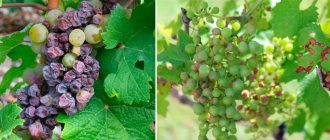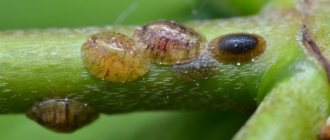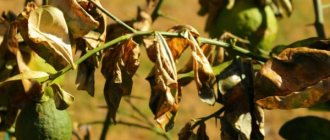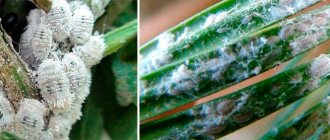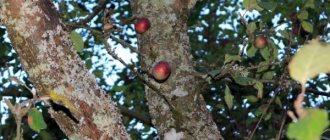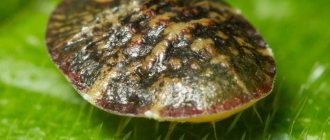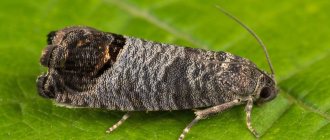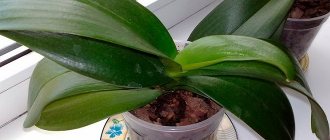Bacterial pear cancer treatment. Burn symptoms
Depending on the stage of development of the pear the infection occurred, the following symptoms are distinguished:
- When infected at the stage of development and bud opening, their darkening and drying are observed.
- The flowering phase is characterized by darkening of flowers and their subsequent wilting.
- At an advanced stage of the burn, white discharge from the bark is characteristic, which later acquires a brown tint. The trunk itself becomes covered with bubbles and stains. All these symptoms can be seen in the photo below.
If the fruits have time to set before the bacterial burn appears, then they subsequently darken and dry out. In this state they remain on the tree until winter. If you do not treat the tree, in 1-2 years the entire garden will be completely destroyed.
Novice gardeners are not always able to detect bacterial burns in time. And there may be several reasons for this:
- The disease develops from the top, so if there is a tall tree, it can be detected when the darkening of the leaves has reached the middle of the crown. At this stage, treatment is almost impossible and requires complete removal of the pear.
- Mistaking symptoms for lack of moisture. In this case, gardeners begin to intensively water the pear, contributing to the spread of the disease.
- Mistaking a fire burn for bacterial cancer. In this case, the exact cause can be established by conducting laboratory tests.
Fire blight is a disease of fruit trees that is widespread in Australia, the USA, Canada, Japan and some European countries.
In recent years, this disease has appeared in western Ukraine. Fire blight in most cases affects plants of the Rosaceae family. Boles, shoots, leaves, roots, and fruits are affected.
This disease affects flowers in early spring. After this, they wither, and then dry up and remain on the tree until late autumn. Bacteria spread from the affected flowers to shoots and leaves. Thus, everything is affected
This disease is caused by bacteria from the genus Erwinia amylovora. North America is considered to be the birthplace of this disease, from where the bacteria spread throughout the world.
The greatest losses of fruit trees that were affected by fire blight were recorded in Australia and New Zealand.
Soon the bacteria spread to Japan, where they began to actively infect pear trees. For a long time, Japanese agronomists could not understand the cause of the disease in fruit trees, and only a few years later a certain scientist identified the cause of the disease - a gram-negative aerobe.
Many gardeners do not know how to recognize this terrible disease, which is why they waste a lot of time, and meanwhile there is less and less chance of saving the tree. Among such ailments, the most dangerous is the bacterial burn of the pear. Treatment depends on how quickly the correct diagnosis is made, and whether there are other trees in the immediate area that may be infested.
The first time a bacterial burn was recorded was in the eighteenth century. After about 150 years, the disease spread throughout the continent. Now it is found all over the world, regularly devastating gardens. All above-ground parts of the plant are affected by bacterial blight of the pear. Treatment must be started at the earliest stages, otherwise it may not be effective.
Who is the causative agent of the disease?
The bacterium Erwinia Amilovora was first identified in the United States. It is this that causes bacterial burn, which causes pear and apple trees to dry out. Among gardeners, the disease is often called Erwinia. Previously, the infection affected orchards in America (Canada, USA) and Australia. Now trees with signs of bacterial burn can be found in Russian amateur and industrial gardens.
A dangerous disease that causes massive death of fruit trees appeared in the south of the country in the 90s of the last century and continues to spread. Fighting infection is difficult because bacteria affect all tissues, even those deep under the bark. Microbes parasitize in the sap, blood vessels, and cambium. Without proper treatment, an infected pear dies within 2-3 years.
Treatment of bacterial burn in pear
The most popular method of fighting “Antonov fire” is the use of copper sulfate in combination with a lime solution. When the components are correctly proportioned and dosed, this composition turns out to be quite effective. Quite often, a very large amount of vitriol can lead to scorching of the leaves, and a shortage leads to the loss of healing properties.
When all the efforts made have not led to a positive result, it is recommended to use a method of treating wood using fungicidal agents.
Some summer residents are inclined to use radical methods to eradicate this disease - uproot the infected tree and burn it. It is absolutely prohibited to move the plant to other areas of the garden territory, since there is a high probability of the spread of pathogenic organisms in areas where healthy plants grow. Some gardeners consider it quite appropriate to destroy all fruit trees in the immediate vicinity of the source of infection.
Tools that were used while working with infected wood must subsequently be disinfected with formaldehyde or carbolic acid. The use of this method is justified only if the treatment has not yet led to a positive result - in some situations it is worth sacrificing one tree in order to subsequently save all garden crops.
Scientific achievements do not stand still and today there is a wide range of different products that can effectively destroy bacterial burns. Among the large number of medications, the following should be highlighted:
- Streptomycin is the most popular antibiotic; its undeniable advantage is its absolute cheapness and general availability.
- Tetracycline is not inferior in popularity to streptomycin, a widespread and inexpensive drug.
- Ofloxacin is a fairly high-quality medicine and belongs to a new generation. Its characteristic feature is its aggressive and powerful effect on the lesion. It must be used strictly following the indicated dosages.
- Fitosporin is a medicinal product recommended for use only during severe infection of the pear. Reduces the degree and rate of putrefactive processes in the tree structure.
When getting rid of the disease, it is necessary to spray not only the inflorescences, shoots and leaves, but also the tree trunk itself.
It is strictly forbidden to spray the pear on hot days; it is best to give preference to cloudy weather, due to the fact that if you treat the tree with a solution of the above-described products in the sun, then under the influence of direct rays of the sun the beneficial microorganisms will simply die.
The antibiotics listed above are modern drugs for getting rid of fire blight in fruit trees, including pears.
The most important thing to remember is that treatment with antibacterial agents is not a panacea for this disease. Simply, regular use of all the above-mentioned means leads to the fact that the causative agent of the disease undergoes mutation at the genetic level and develops resistance to their action. To improve the bio- and microclimate, it is recommended to lay rotting grass near the trunk of the pear. These actions create favorable conditions for the development of beneficial organisms that kill pathogenic bacteria.
As a result, it should be noted that this disease is quite dangerous for various fruit trees, but if the disease is detected in a timely manner, the tree can still be saved.
Processing terms and rules
Chemicals are not a cure for a dangerous disease. With regular use, the pathogen can mutate.
It is not recommended to spray the garden during hot daylight hours. Beneficial microorganisms can die in the sun. Preference is given to cloudy weather.
Treatment with chemicals will be performed several times per season:
- during swelling of the kidneys;
- at the moment of their blossoming;
- after flowering;
- 2 weeks after the previous treatment;
- after harvest.
Treatment of bacterial burn of pears is also carried out with antibiotics in the fall. When using medications, be sure to follow the instructions on the packaging. The frequency and dosage depend on the degree of damage.
How to cure a pear disease
If prevention does not produce results, treatment is immediately started, which is carried out in various ways and is not stopped until the effect is achieved.
Antibiotics against bacterial blight of pear
Treating fire blight with antibiotics is effective. However, recently there has been a ban on the sale of drugs of this type without a prescription, which complicates the purchase of drugs.
Common substances are used.
Streptomycin for spraying must be diluted with clean water. Add 5 liters of water to one 2 ml ampoule. Spraying is repeated every three weeks until the pear recovers. Prevention should begin in mid-May.
Gentamicin is diluted in a ratio of 2 ml per 1 liter of water. Spray at least three times with a break of 5 days.
Experts recommend mixing the antibiotic with the drug “Skor” at the flowering stage. During the growing season, shoots use combinations with “Hom”, “Tsineb”, “Acrobat”.
Tetracycline is sprayed no more than once a season. Dosage – 1 tablet per 2 liters of water. Can be used in combination with Streptomycin.
Chemicals
To prevent and delay the spread of bacterial burns, preparations based on copper oxides are used: “Hom”, copper sulfate, Bordeaux mixture.
The disadvantage of chemicals is that they destroy bacteria upon direct contact. The pathogens hidden under the bark will not be harmed.
Biological methods of control
Biological fungicides contain bacteria that are antagonists to the causative agent of the burn.
Such products have a number of advantages over purely chemical substances:
- long period of validity;
- treatment, not just stopping reproduction and spread;
- destructive effect on pathogenic fungi that form a symbiosis with the causative agent of the burn.
Preparations based on Bacillus bacteria are common: Fitosporin, Baktofit, Gamair, Alirin.
Pseudobacterin, Elena, Planriz, Binoram are created based on Pseudomonas bacteria.
The third category of fungicides contains Streptomyces lavendulae. Popular drug Fitolavin. It is sold in gardening stores and used according to the dosage specified by the manufacturer. Treatment with Fitolavin is possible at the stages of budding, flowering, and the appearance of ovaries.
It is important to follow the recommendations, number and frequency of treatments specified by the manufacturer
Traditional methods and recipe
Gardeners who advocate for a clean garden try to make do with folk remedies.
However, practice shows that methods can be effective only in the early stages of the disease, as a preventive measure or an additional remedy.
Gardening forums recommend spraying with boric or succinic acid dissolved in water in a ratio of 10 g of the drug per 10 liters of water.
The action is based on the creation of an acidic environment, which creates an obstacle to the spread of bacteria and reduces the rate of reproduction. At the same time, the solution quickly decomposes and dries out, becoming useless. Rain and wind make concentration of drugs useless.
The immune system can be supported with solutions of wood ash, which contains a high concentration of potassium and phosphorus. Spraying with such preparations only improves the immunity of the pear. A common recipe is: 200 g of ash is diluted in 10 liters of water and sprayed.
Nutritional yeast can temporarily suppress bacterial growth. Mix 10 g of yeast with 2 tablespoons of sugar. Let it steep in 10 liters of warm water for 2 hours. Trees are sprayed with the solution.
Radical measures
Drastic measures are used in large gardens and personal plots.
If up to 30% of the branches and leaves are affected, the diseased areas are cut off and destroyed. The cut areas are disinfected and covered with garden varnish.
Agronomists do not recommend preserving or treating a tree if more than 30% of the plant is affected. Such specimens are uprooted and burned. Before planting a new seedling, the soil is disinfected.
How to act, what to process
The main rule for treating a pear for a disease such as bacterial burn is timeliness. If you ignore dangerous symptoms at an early stage of the problem, it will worsen, and no measures will help. A positive result is not guaranteed, even if therapy is started in a timely manner, because much depends on the accompanying and complicating factors of the problem.
Experienced gardeners recommend paying attention to the fact that therapy should be comprehensive. Treatment in all cases involves the use of chemical and antibacterial drugs
It is not so easy to destroy erwinia, so you should not try to save the crop this season. The main goal is to save the plant itself or part of it from death. Most likely, after the fruits are cured, you will have to wait several years, and then the growing season will be restored.
Chemicals
Positive results are achieved when pears are treated with modern antibacterial agents. Chemicals are used to prevent damage or in the early stages of its detection, when other means are not available. It is better to choose those that contain copper. Others will not be as effective.
Gardeners advise taking Bordeaux mixture and applying it several times a season. Be sure to spray the garden in early spring, during the period of fruit formation, and in the fall (when the pear sheds its leaves). Before processing, the affected parts are removed and burned.
Antibiotics
Antibacterial agents are used to treat and prevent dangerous pear diseases. The basic rule is to regularly change the active substance, because the bacterium quickly develops immunity to it.
Ampoules with the solution can be bought at a regular pharmacy. The following medications are suitable:
- "Ofloxacin";
- "Levomycetin";
- "Tetracycline";
- "Ampicillin";
- "Streptomycin";
- "Gentamicin."
The procedure is recommended to be carried out in the spring, about 2 weeks before the expected start of flowering. The resulting solution is used to treat trees from top to bottom; watering at the root is possible.
If the disease is detected suddenly, they do not adhere to deadlines and act urgently. The only thing is that it is better to spray in the evening, when the temperature drops. This way the drugs will be better absorbed.
The following video will tell you how to treat a pear.
Bacteriological methods
Such methods should not be used to contain a disease outbreak. They are ineffective, so experienced gardeners advise using them for preventive treatments in early spring. Their main advantage is safety for the plant itself and humans.
To achieve results, you must follow the rules dictated by the characteristics of the drugs. They contain beneficial bacteria that can destroy harmful organisms. They are used during the first warming, when the air warms up to 18-25 degrees.
Effectiveness appears within 7 days. If it rains during this period, the treatment must be repeated. Popular drugs in this group: Gamair and Fitosporin. You need to dilute the products according to the instructions.
Radical technique
It is better to destroy a quickly blackening pear immediately to avoid spreading the problem throughout the garden. The tree is uprooted and burned, all weeds are removed. Afterwards, the garden is treated with antibacterial drugs and insecticides once every 5 days, making at least 3 sprays.
If one side of the pear is affected by the disease, you can fight for it. All parts of concern are trimmed away, including healthy tissue, to remove the source of infection.
Sections and tools are disinfected with alcohol and then sealed with garden varnish. After completing the work, spray with antibiotics or copper sulfate. The condition of the plant is monitored. If the blackening spreads, the tree is uprooted.
How to fight bacteriosis
A bacterial burn is dangerous because its first symptoms are similar to those of diseases caused by fungi. Many gardeners treat pears infected with bacteria using fungicides (“HOM”, “Skor”). These drugs do not have the desired effect, the trees continue to hurt, time is running out, they are effective against moniliosis and cytosporosis.
Erwinia needs to be combated in the spring and comprehensively, treating pears with fungicides and antibiotics.
Any spraying with drugs is effective in a short period of time, it lasts a maximum of 2 weeks. Bacteria emerge from the capsules from the beginning of sap flow and are vulnerable before flowering begins.
It is important for the gardener not to miss the moment when sticky exudate appears on the bark. One drop contains millions of bacteria
They are spread over a large area by wind, rain and insects, infecting new trees.
We use chemicals
Before the leaves appear, the trunk and branches of the pear are treated with chemicals containing copper or zinc:
- "HOM";
- "Zineb."
You should not use copper sulfate or Bordeaux mixture. They are very toxic and harm plants. Treatment with chemicals should be completed 5 days before flowering begins. “HOM” and “Zineb” do not destroy bacteria, they inhibit their reproduction and kill the fungal infection that always accompanies a bacterial burn.
Antibiotics
Antibacterial drugs are used before flowering, at the beginning and end of flowering. When exudate appears, pears are given a lotion with Ofloxacin solution. Dissolve 1 tablet in a liter of water, remove the viscous mucus, and apply a rag soaked in an antibiotic solution to the wound.
"Streptomycin"
The inexpensive drug is successfully used in industrial and amateur gardens. To obtain a working solution, it is enough to dilute 1 ampoule in 5 liters of water. Pears with signs of bacterial burn are sprayed every 20 days, treatment begins in May.
"Gentamicin"
During the summer, pears are sprayed at least 3 times with an interval of 5 days. Method of using the working solution:
- water - 1 l;
- ampoule 2 ml - 1 pc.
"Tetracycline"
An antibiotic is used no more than once a year. Dissolve 2 tablets in 3 liters of water. The effectiveness of the antibiotic increases when Tetracycline is used simultaneously with Streptomycin. Spraying is not carried out in hot weather; at high temperatures, the antibacterial properties of the solution are reduced.
"Fitolavin"
To process one adult pear during the growing season, the formation of buds and ovaries, 2 to 5 liters of working fluid are required. It is prepared in the following proportions:
- water - 10 l;
- "Fitolavin" - 20 ml.
The antibiotic is used at the very end of flowering in a mixture with the drug "Skor", during the active growth of shoots it is combined with the products "Zineb", "HOM", "Acrobat". The Fitolavina solution works during cold weather.
Folk remedies
There are no effective recipes for fire blight on pears, so gardeners usually do not consider using traditional methods. There is evidence that the drug “Farmayod” helps against bacterial burns. It is used according to the scheme shown in the table.
| Phase | Amount of “Farmayod” per 10 liters of water (ml) |
| Green cone | 5 |
| The appearance of the first pink buds | 5 |
| Formation of ovaries | 10 |
| Pouring fruits | 10 |
Pears are sprayed in calm, dry weather, not late in the evening or early in the morning.
Cardinal methods
Radical methods of control are resorted to if the garden is large and has many young fruit trees. Blackened trees affected by bacteria are uprooted and burned. The place where they grew is cleared of weeds.
The remaining pears and apple trees are treated with an antibiotic solution every week. To prevent addiction, medications are alternated. Trees with the first signs of erwinia are examined using clean tools, and diseased branches are cut out.
Finally, the pears are treated with a mixture of antibiotic and copper sulfate. If there are diseased trees in the garden, then all the buds of young pears are cut off during the first 2 years. This reduces the risk of infection with bacteriosis through flower buds.
| Degree of tree infection | Control measures |
| Crown drying out > 30% | Uprooting and burning trees |
| Drying of the crown | Removing diseased branches while capturing healthy wood |
Ways to get rid of plant disease
At the initial stage, the disease is suppressed by various means. But first you need to completely clean the seedling. Using treated pruning shears, remove all diseased shoots, capturing up to 20 cm of healthy tissue. Pity is inappropriate here!
If there are cracks on the pear bark with exudate oozing, wipe the liquid with a rag soaked in a solution of copper sulfate. Then clean the wound with a garden knife, removing all damaged areas down to healthy tissue. Prepare a gauze pad and antibiotic solution. Dissolve 2 tablets of the drug in a two-liter jar. Moisten the cloth and apply it to the wound surface, secure with cling film.
All plant residues must be immediately destroyed. Never bury cut branches. They should not be placed in a compost bin. It is best to burn the source of infection.
Treatment with chemicals
Treatment of the initial stage of a bacterial burn of a pear is carried out through five-time treatment with copper-containing preparations.
Bordeaux mixture has long been used by gardeners as a fungicide. When preparing the solution, observe the proportions, since excess copper sulfate leads to a chemical burn. Purchase copper-containing preparations at the garden center - Skor, Oxychom, copper oxychloride. They suppress the development of Erwinia from the outside, disinfecting the surface. In this case, insects will no longer spread the bacteria.
After complete stripping, spray the pear tree with the prepared solution. The procedure is carried out in five stages:
- when the kidneys awaken;
- during the blooming of the deciduous mass;
- at the end of flowering;
- 15 days after the last spraying;
- at the end of the harvest.
If copper-containing preparations do not give the required effect and the seedling continues to wither, it is advisable to switch to more serious methods - use antibiotics.
Medicines (antibiotics) from the pharmacy
Antimicrobial drugs for humans have shown excellent results in the treatment of fire blight. The action is based on the destruction of the DNA chain of the phytopathogen. Treatment is carried out once every 20 days from the moment the leaves appear. It is not advisable to use the same antibiotic more than one season, because bacteria gradually acquire immunity to it.
To treat a tree, gardeners use the following medicines:
- streptomycin. It is diluted at the rate of 500 mg (1 ampoule) per 5 liters of water;
- tetracycline drugs. Two tablets per three-liter jar of water are enough;
- ofloxacin. Two tablets per bucket of water;
- gentamicin. A 2 mg ampoule dissolves in a liter of water.
Between treatments, use biostimulants that will support the plant’s immunity. The following video will tell you more about treating bacterial burns with antibiotics.
A little trick
To protect the garden from spreading Erwinia, before the buds bloom, spray the trees with an antibiotic solution, to which add 200 g of sugar and a little honey. This will distract insects from the exudate and lead to the death of bacteria.
Uproot plants that provoke the disease - hawthorn, wild stone fruits.
Drastic measures to combat
An infected pear can destroy an entire garden, so some gardeners prefer to immediately use uprooting. The dug up specimen is burned.
New means of struggle
Among the new drugs for fire blight, gardeners preferred:
- Previkura. Blocks the ability of microorganisms to reproduce, destroys fungi, improves immunity;
- Bionuru, Tioferu. Used to prevent frost damage;
- Stimeksam, Gamaira. Microbiological preparations containing beneficial flora.
Traditional methods are not used in the treatment of the disease. This is due to the recent emergence of the disease and increased resistance of the pathogen. In the early stages of infection, gardeners use Farmayod, which is diluted in 10 ml per bucket of water. Spray the tree during budding and fruit filling.
Prevention
The occurrence of bacterial burns on pears can be prevented. To do this, just follow these simple preventive recommendations:
- Monitor the condition of your site. Remove all wild plants immediately. It is imperative that hawthorn be removed from the area, since it is most often the source of infection.
- Promptly combat pests, such as gall mites, aphids, which can transfer the causative agent of fire blight to your area.
- Treat pears with copper-based fungicides twice a year. This must be done if plants in neighboring areas have already suffered from bacterial burns.
- Prevent sun and frost burns of wood. The damaged areas of the tree must be treated with garden varnish or other substances used for this purpose.
- Whitewash the trunks.
- Treat trees with drugs that enhance immunity. For this purpose, you can use Ecogel, Silk, Narcissus and others.
- A few days before the pear blossoms, spray the branches with an antibiotic solution adding a glass of sugar or a spoonful of honey to a bucket of water. This remedy will prevent the spread of infection by insects.
You can read about how to properly prune a pear tree in spring in this article.
You can prevent fire blight from occurring on fruit trees if you follow the regular rules for organizing gardening work:
- Systematic control of harmful insects that carry infection. The main enemies are aphids and gall mites.
- Keeping the soda area clean. As it grows, you should uproot wild growths, mow or weed weeds. Hawthorn cannot be grown in the garden, as it is most often a source of fire blight.
- Carrying out preventive procedures for healing sun and frost burns twice a season. Cracks and splits are covered with garden varnish.
- Treatment of pears with copper-containing fungicides. Especially if signs of the disease are found in neighboring areas.
- A few days before flowering, spray the pear with an antibiotic-based product, which will prevent the spread of bacterial burns and infections. The solution also includes 1 tbsp. sugar, 1 tbsp. l. honey and 10 liters of water. Bees and other insects prefer to drink the sweet mixture and stop sucking out secretions containing bacteria that have been chemically treated.
- Spray fruit plantings with immunostimulants.
- Whitewashing of trunks.
- Constantly inspect the leaves and shoots of fruit plantings. When the first symptoms appear, carry out local treatment.
Treating a bacterial burn is not an easy task. This is not always within the capabilities of experienced gardeners. Therefore, beginners are advised to choose pear varieties that are resistant to the disease for planting. The varieties listed below practically do not suffer from bacterial disease:
- Bere Gardi;
- Williams;
- Conference;
- Duranda;
- Lukashovka;
- General Leclerc;
- Favorite.
Description of the disease
The first bacterial burn of plants was recorded at the end of the 18th century. The signs were discovered on fruit crops in the American state of New York; they spread very quickly and after a few months they were reported by gardeners in Canada and Mexico. In the middle of the last century, the bacterium Erwinia Amylovora already caused fire blight on trees in Europe, Asia, Australia, and New Zealand. The disease spread so quickly through orchards that, for example, in Armenia it was necessary to destroy entire pear and quince plantations.
The bacterium Erwinia Amylovora is resistant to adverse weather conditions and survives in winter thanks to its ability to “fall asleep” for a long time. In the spring, the bacterium emerges from the sleep phase and begins active life and reproduction.
The causative agent of bacterial burn quickly spread throughout the world due to the fact that it is able to “move” with precipitation and wind currents. The bacterium enters household plots with infected seedlings, on the legs of birds, and on the bodies of insects, both pests and pollinators. The lightning-fast infection of all fruit trees on the site is often provoked by the gardeners themselves - having pruned or uprooted one tree, they begin to work with another without sanitizing the tools.
Related article:
Apple tree diseases and pests
Symptoms
Fire blight kills affected trees very quickly. This can happen in just one season. Symptoms are conventionally divided by scientists and gardeners into 4 main stages:
- latent - necrotic veins of a reddish hue or dark brown oblong spots appear along the veins of the foliage on leaves and fruits,
- active - the flowers of the trees become dark brown, turn black, dry out to the state of a mummy, but do not fall off, the fruits are covered with drops of gum, turn yellow, young branches and shoots turn into withered “shepherd’s crooks”,
- secondary infection - at this phase, the so-called “bacterial leak” begins, the disease spreads throughout the garden with the wind, rain washes off the branches onto the trunk of the plant, sticky drops appear on the affected shoots of the “sick” one, turning brown in the sun,
- terminal - at this stage, an irreversible change in the tree bark occurs, it thickens, cracks, mucus begins to secrete from the wounds, the wood is affected - it becomes loose, red-brown or milky white.
Related article:
Effective pest control in garden beds
Erwinia Amylovora most often affects fruit trees from the Rosaceae family - apricots, pears, quince, apple trees, rowan, bush hawthorn, shadberry.
The main route of spread is the transfer of micro drops of moisture (exudate) released from wounds on diseased trees. One such drop can contain up to a million bacteria that cause fire blight. There are many, many ways to spread the disease – from birds, insects to precipitation and gardening tools. Therefore, it is important to notice its symptoms in time and begin treatment of the fruit tree.
What is fire blight?
Fire blight is considered one of the most serious ailments that can affect a pear. All over the world, specialists are making a lot of efforts to combat the disease. Despite this, the disease still actively destroys the crop and causes the death of trees.
The first case of defeat was recorded in the eighteenth century. This happened in the eastern United States of America, near New York. Over the next 150 years, the disease spread throughout the continent, and then spread beyond its borders. Currently, this disease occurs almost all over the world, including in the post-Soviet space.
The disease affects all parts of the tree located above the ground: shoots, leaves, branches, buds and flowers. The disease process usually begins in inflorescences, after which it quickly spreads to branches and shoots. The opening of the affected kidneys is suspended. They turn black and begin to dry out, but do not fall off.
The flowers also darken and wither. Leaves and young twigs begin to turn black at the tips. They curl, and the infection quickly moves towards the trunk. In this case, the leaves remain on the branches for a long time. A sick pear looks like it has been burned by fire.
The bark softens. Small drops of milky white color appear on it. The released liquid is called exudate. The cut of the bark in the places where droplets appear has a specific pattern. Red-brown stains are clearly visible on it.
Infected tissue peels off and becomes blistered. The bark begins to crack, and a contrasting transition is clearly visible at the boundaries between healthy and affected areas. Characteristic cankers form on the tree. Appearing first on the branches, they spread along the entire length of the trunk. As you can see in the photo, the bacterial burn does not bypass the fruits either. Similar to the affected leaves, they turn black, but remain hanging on the pear.
Signs and symptoms
The first symptoms of pear disease appear on the branches of the plant. In spring, bud development on the tree slows down. If the branches already have leaves, they gradually turn black and dry out, but do not fall off. The same thing happens with twigs. If the disease affects the tree while the fruits are ripening, they will also turn black and dry out. During flowering, bacterial burn also provokes blackening of flowers; fruit formation does not occur on the affected branches.
Read about treating pears in spring against pests and diseases here.
A pear affected by this disease is visually similar to a burnt tree - it turns black, dries out, but does not crumble.
If the gardener does not remove all blackened areas of the tree in the first stages of the disease, the disease will affect the tree trunk. The bark on it softens, large white spots appear on it, which quickly darken. Characteristic brown stains form around the affected areas. Later, the affected areas of the bark peel off, and large ulcers form on the pear itself.
If the disease affects the trunk, it is usually impossible to save the plant. The gardener needs to remove it from the site as quickly as possible so that it does not become a source of infection for neighboring pears. If treatment is started at earlier stages, the tree can be saved in the vast majority of cases.
What are the symptoms of a bacterial burn?
With a bacterial burn, changes occur throughout the entire tree. The main symptom is a change in the condition of the bark, in which it appears sticky and becomes covered with a white exudate. Over time, the exudate turns brown. With this disease, red areas appear on the leaves, which are located between the veins of the leaf blade.
Bacterial burn of fruit trees
In addition, shoots, flowers and fruits change. The shoots bend and wither. There is a blackening of their tips, very similar to a burn. Flowers and buds turn brown and gradually die off. The ovaries darken and stop growing.
Important! Exudate also often appears on fruits, which contributes to mummification of the fruit. The fruit can remain on the branch in this state for more than a year.
The infection develops and is transmitted as follows:
- When Erwinia first enters the wood, it starts the reproduction process, but during the first wintering almost all bacteria die. Only 10% of survivors, with the arrival of spring, activate all their forces to rapidly increase their numbers, which leads to the release of exudate.
- When the flowering period begins, insects, pests and birds, when visiting a diseased tree, pick up some of the bacteria on their paws.
- Subsequently, the disease is transferred by them to healthy plants, in which erwinias continue to grow in nectar and along the peduncle reach the vascular system, and through it to all organs and tissues of the plant.
- When the entire system is damaged, the bacteria awakens genes that produce toxins. These substances block the fruit tree’s immunity and lead to tissue death. There is even more exudate. The ovaries gradually die off.
- The dead tissue continues to hold tightly to the branch. And new “visitors” to the tree after contact again suffer the disease and start the cycle all over again.
Fire blight spreads very quickly
How does reproduction occur?
Death of young ovaries.
From the very beginning, it falls into a crack in the bark and stays there quietly so as not to freeze in the winter.
Its main task is to increase in quantity before sap flow, and then get out.
As soon as milky white drops , you can expect the complete destruction of the garden in a few years. These droplets attract flies, wasps and other insects, which transfer them to other trees during the flowering process, thereby infecting millions of inflorescences.
At an air temperature of 20 degrees Celsius, millions of Erwinias become billions in a matter of days, multiplying every 20 minutes . Moreover, its number is growing exponentially at tremendous speed. If the weather outside is warm and humid, then the Americana is able to reproduce even in droplets of water.
Moreover, Erwinia very quickly combines with a variety of bacteria and fungi, affecting the entire tree.
Treatment
Exudate is intensely released when watering an apple tree and attracts flies, which spread the infection further
. Error No. 1. Incorrect diagnosis. Confusing bacteriosis with drying out, gardeners begin to intensively water apple trees, which provokes the active development of infection.
Mistake #2. Treatment of bacteriosis with fungicides. Fungicides are remedies against fungal diseases, and erwinia is not a fungus. Drugs like HOM and Horus are powerless against it.
Mistake #3. They leave mummified fruits on the branches. This often happens in orchards with tall apple trees, the crown of which is difficult to care for. It’s not for nothing that the bacterium prevents the fruits from falling off. She uses them as a reservoir for wintering, and in the spring she will again penetrate through the stalks deep into the wood.
1. Uproot Hawthorn and wild fruit plants if you find them nearby, as foci of infection can easily persist in them.
2. During the flowering period, treat your garden five times with antibiotics (oxytetracycline, streptomycin are recommended) or the so-called Bordeaux mixture - this is a sky-blue solution of copper sulfate CuSO4 × 5H2O in lime milk Ca(OH)2. When preparing this mixture yourself, take care to control its acidity. It should be neutral (pH = 7.0). Excess vitriol will burn the sprayed leaves. Excess lime will reduce the killing power.
2a. Instead of Bordeaux mixture, you can use other fungicides containing copper Cu.
2b. Consider the unfortunate fact that regular spraying of these chemicals on gardens in Washington State and California has caused the bacterium Erwinia amylovora to mutate into varieties that are resistant to this method of protection.
3. Inhibit the activity of living exudate carriers.
4. If infection cannot be avoided, but it is noticed in a timely manner, cut off all branches at a distance of at least 20 centimeters from the affected area. Burn the scraps immediately.
5. If you see that it will no longer be possible to save the tree by pruning, uproot it and burn it, without moving anywhere from the hole.
6. Disinfect tools and containers.
7. Do not buy planting material in areas where foci of this disease have been identified (Belgorod, Voronezh, Kaliningrad, Samara, Saratov, Tambov regions, as well as the Karachay-Cherkess Republic in Russia, Myadel and Uzdensky districts of the Minsk region of the Republic of Belarus).
8. New varieties of fruit crops may have increased resistance to fire blight. Be sure to take an interest in this characteristic when you intend to purchase seedlings.
Ways to combat fire blight
To identify the causative agent of the disease and begin treatment, the tips of the branches and bark of the withering tree are taken to a special laboratory, where bacteriological seeding begins. To cope with an infection caused by Erwinia, not one, but several methods of eliminating it are used, each of which has its own advantages, but is not without its disadvantages.
Before using any of the methods, remove infected shoots by lubricating the cut area with copper sulfate. If the damage is extensive, the tree is dug up and burned.
Chemical method
If signs of bacterial burn are detected, when it appears, the pears are treated with fungicides that contain copper - “Oxychom”, “Skor”, “Rovral” or sprayed with vitriol, adding a 1% solution of the drug to milk made from quicklime .
The procedure begins:
- Before the buds swell.
- When leaves appear.
- After flowering.
- During the formation of the ovary.
The last processing is carried out in the fall, after collecting all the fruits. It is not always possible to cure a pear tree using this method, since Erwinia quickly gets used to the drugs.
Radical method
If fire blight is discovered on one plant, it is destroyed to preserve the garden. When only branches or 1/3 of the tree are infected, the infected shoots are removed, capturing up to 40 cm of healthy tissue. The sections are treated with copper sulfate, stirring half a glass of the substance in a bucket of water. Ferrous sulfate is suitable for this purpose; 70 g of the product is enough for 10 liters.
Infected parts of the pear are burned and cannot be stored or used as firewood. After the procedure, instruments are disinfected in potassium permanganate or dichloramine.
Use of antibiotics
Very often, treatment with fungicides in the fight against a disease caused by an anaerobic microorganism turns out to be ineffective, and it is necessary to use antibacterial drugs that are sprayed on the entire tree, not missing healthy areas.
This product is a waste product of actinomycetes and combines the functions of a biological fungicide with the action of an antibacterial drug. Penetrating into the tissues of the tree, “Fitolavin” spreads through their vessels, but does not accumulate in the ground, and helps strengthen the root system of the pear. After treating the plant with the drug, beneficial microorganisms also die.
To prepare the solution, add 20 ml of “Fitolavina” to a bucket of settled water, spray the leaves with the composition, and water the tree trunk. The product quickly loses its properties; pears must be treated within 2–3 hours.
"Tetracycline"
When the first signs of bacterial burn infection appear, a tablet of this antibiotic containing 100 g of the active ingredient is mixed with water. Spray the tree once.
"Gentamicin"
A drug from the aminoglycoside group destroys gram-negative bacteria and is active against Erwinia amylovora. To prepare a composition for treating pears, combine 2 ampoules of Gentamicin with 1 liter of water. The tree is sprayed three times, maintaining an interval of 5 days after the procedure.
"Streptomycin"
This antibiotic is used to treat industrial plantings because it is inexpensive. In order to spray 10 plants, 5 liters of a composition prepared from water and an ampoule of Streptomycin is enough.
The product cannot be used for 2 or 3 years in a row; it is better to alternate it with Gentamicin, since Erwinia gets used to the active component and it stops helping. How to dilute the preparation for spraying pears is indicated in the annotation, if you buy such antibacterial agents not in a pharmacy, but in specialized gardening centers.
About folk and alternative methods
Infection of a tree with a bacterial burn can lead to its death. It is impossible to destroy the causative agent of the disease by spraying the plant with decoctions of celandine or infusion of garlic and other folk remedies. Agronomists advise first destroying harmful microorganisms, and then restoring beneficial microflora in the garden.
For the prevention and treatment of bacterial and fungal diseases, the following is used:
- "Trichodermin." The mycelial spores present in it germinate into the soil. By releasing toxic substances during their life processes, they destroy pathogenic microorganisms.
- “Pseudobacterin,” which is produced on the basis of a live culture of a microbe, has a negative effect on harmful flora and accelerates the growth of trees.
- “Mycoplant” performs the functions of a fungicide and improves the formation of vermicompost in the soil.
Some gardeners water pears in the spring with Previkur Energy, although the product is intended to protect vegetable crops from diseases, it strengthens the trees’ immunity and prevents the proliferation of microbes.
Main reasons
The source of the infectious process is often trees and shrubs infected with enterobacteria. A liquid containing microorganisms and small particles flows from their bark. They spread easily - with air flow, and are carried by insects and birds.
It is absolutely not necessary to have an affected plant in your area; the infection can “come” from neighbors. That is why the main danger is represented by abandoned garden areas located nearby.
The rate at which the lesion develops depends on several factors:
- variety, its resistance to bacteria;
- the age of the tree and the state of its immunity;
- development conditions.
It is important to consider that elevated temperature and humidity are considered favorable for enterobacteria. Infection is more likely to occur in summer during rainy weather. In spring and autumn, when the temperature does not rise above 18 degrees during the day, there is practically no danger.
Fire blight peaks in spring. This is due to the fact that the infection penetrates the tissues in August, and the first signs are difficult to detect in September-October due to the completion of the growing season.
Causes of bacterial burns
The main cause of bacterial burn is considered to be wasps. These insects feed on exudate (mucous liquid) during the growing season.
This liquid is secreted by the pear tree in places that are affected by bacteria. As a result, the wasps spread millions of bacterial rods to other trees. This is especially dangerous when there are a large number of young pear seedlings growing in the garden.
Also, this disease can spread in the root zone (in cases where trees in the garden grow close to each other). Gardeners often think that the roots are affected by ordinary root rot, so they ignore the dangerous disease. Sometimes amber or milky droplets can be observed on the affected leaves and flowers of a pear. These droplets contain several million bacterial rods, which are spread to other trees by flies and other insects.
Fire blight can be caused by strong wind, rain or fog. Bad weather conditions can spread droplets filled with bacteria to the flowers and leaves of other plants.
Symptoms and causes of the disease
The first signs of the disease become visible in the spring. The main symptoms indicating the attack of a dangerous disease are as follows:
- young branches begin to dry out, become deformed and take on the shape of a hook;
- the tree bark takes on a reddish tint;
- fruits on dried branches turn black and mummify;
- the foliage on the trees also becomes black and crumbles;
- droplets of cloudy whitish liquid appear on the surface of the plant;
- kidneys stop developing;
- the blossoming inflorescences gradually darken and dry out.
Young trees almost always become victims of Erwinia. Old pears growing next to infected young ones are usually out of the risk zone.
The spread of infection between plants occurs in four main ways:
- downwind. Thin threads are formed from the viscous substance of the exudate, which are carried by the wind to other plants. The pathogen begins to multiply, getting on the inflorescences or in open wounds of the tree;
- with raindrops. The pathogen can spread to neighboring plants in droplets of rainwater due to strong gusts of wind;
- through gardening tools. When performing sanitary trimming and shaping, infection may remain on the surface of the instruments. If, when switching to another plant, the instrument is not properly disinfected, then the disease will easily affect it;
- with the help of insects. The most common cause of spread is bees. When pollinating trees, they transfer the infection from flower to flower. However, other pests that can move between different plants can also spread the disease throughout the garden.
Organic products and treatments based on them
The sooner you notice signs of fire blight, the better your chances of saving your orchard.
They contain a dozen beneficial bacteria that can protect the garden better than antibiotics. Moreover, such auxiliary elements perfectly protect the plant from fungi and bacteria. In addition to many specific additives, they also contain beneficial bacteria, which are recognized as completely environmentally friendly and safe for fruit trees. Thus, it is possible to bring the ACN indicator of both adjacent soil and foliage into order in a relatively short period of time.
Some gardeners completely abandon routine mulching and weed removal, simply preferring mineral-based fertilizers. However, organic fertilizers are still preferable. Only in this way can the natural biodiversity of the local soil be restored.
Folk remedies
Bordeaux mixture is time-tested and serves as a fairly effective remedy for the prevention of many pear diseases.
If you adhere to the prescribed dosage, then this remedy is quite effective. If you add too much vitriol, the foliage can be scorched. But adding just a little bit of it will not have enough medicinal properties.
If positive changes are not observed after therapeutic manipulations, then the possibility of using fungicide-based preparations should be considered. But such radical methods are used extremely rarely. If such actions do not help, then the plant should be removed along with the root system. After removal, the plant is burned, since there is a high probability of infection of nearby plants.
